#temporal concept
Explore tagged Tumblr posts
Text
"Childhood is not a temporal concept, but a territory of the soul, always open to those who do not forget to learn and to be amazed." - Maria Waser, Swiss writer Have yourself an amazing new year, y'all!
#quote of the day#quote of today#inspirational quotes#maria waser#childhood#infancy#temporal concept#time#territory#areas#realms#spaces#soul#do not forget#remember#learning#be amazed#2025#all the best#best wishes#happy new year#have a good time#let hope prevail
102 notes
·
View notes
Text
doctor who introduced the concept of a room in the tardis separate from the rest of the universe and from temporal influences and then did nothing with it
#I don't mean absolutely nothing but I mean that it could solve problems like paradoxes or temporal alterations technically and they just.#didn't.#it's such a fun concept though#doctor who#zero room#classic who
240 notes
·
View notes
Text
i should know that i’m going to get a migraine in the next 24 hours if i randomly drop or fling like 4 objects in 1 morning. but i don’t. i’m just like [x files voice] it’s happening again, isn’t it
#i can understand ‘migraine’ but ‘migraine prodrome’ is too hazy a temporal concept#for me to map it to disability things that are functionally true of me half the time#it just folds in to ‘bad motor skills’
9 notes
·
View notes
Text
Every day I wake up regretting getting emotionally invested in Jujutsu Kaisen
#It's both the best and worst thing ever written#So much potential. Wonderful dynamics. Every concept that ever mattered to me personally#which means it's all the best concepts ever in the history of humankind#The most adorable kids. The most gorgeous women. The most whatever Gojo is#Which is pretty much 'everything' considering he is not Jack or Heathcliff#And yet#AND YET#It fails at reaching its full potential on any of the stuff I mentioned#It's truly truly the best thing ever. It's truly also a source of constant dissatisfaction#AND YET AGAIN#When you think 'yeah okay it's too much dissatisfaction it isn't worth it' it hits you again with the best thing ever#I hate it here so much#I wish I didn't get into this at all in general and I specifically wish Gojo Satoru would disappear for good of reality itself#Just *pum* vanished. Like melting water on snow or something#As if he had never been at all. And then I'd have never gotten into this#Anyway... I'm begging everyone who is into Gojo to read Georg Cantor. I have some other authors and texts. I can send stuff#In any case it's all good. I'm sure everything will be forgotten in a couple months#I won't think about this at all in just a little bit more time#Yeah. Pretty sure#It's just a temporal thing with very short time. Almost like an ephemeral fly#Or the lapsus of time in which one could eat cherries yearly#By wintertime this won't be anything at all. At most a red stain on snow that perhaps brings cherries back to memory#Nothing else. Just a little bit more time and it shall pass#But goodness how I wish Gojo Satoru would disappear from my life or the very fabric of reality#I talk too much#I should probably delete this later
7 notes
·
View notes
Text
Re-installed LnD to check out Sylus and... *sigh* I discovered Glint Photobooth.

Oh no. (╥ ᴗ ╥)
#love and deepspace#zayne x rafayel#alternate universe#gay shit#gay gay gay#i will go down with this ship#i love them your honor#zayne love and deepspace#rafayel love and deepspace#zayraf#gay gay homosexual gay#just kiss already#game#yaoi bl#yaoi#gays#brainrot so bad i wanna eat my temporal lobe#story concept#just kidding#i already have so much story concepts saved i don't need another one#especially concerning these two#like give my other ships a chance you idiots#but like#look at them#they look so cute#they should fuck
8 notes
·
View notes
Text
#reminded me of a lecture in college on 19th century victorian literature. mill on the floss i think. the professor spoke of how#agrarian society was in tune with temporal cycle of nature. seasons religious days tides etc. with the first industrial revolution saw a#dramatic shift in the human experience of time with clocks and timekeeping mostly for the time labourers spent toiling in factories#mentioned how time was now 'spent' rather than 'passed'; leisure was taken completely out of daily life. things became task-oriented which#kept on increasing. the factories would tamper with the clock to keep increasing the time labourers worked on the floor.#you can't tamper with the sun and moon now can you?#anyway this also brings to mind the demand for separate timezones in india#also brings to mind the concept of timesheets and how freelancers charge by the hour.#also brings to mind max weber's protestant ethic and the spirit of capitalism for some reason#i side with the luddites
23 notes
·
View notes
Text
Leaving aside the 'preventing America somehow prevents the world from suffering a climate disaster in the 2100s' premise, killing Columbus wouldn't actually prevent colonialism and imperialism and the genocide of the Native Americans.
Like, at all?
Columbus was a shithead, sure, but there were tons of people worse than him. What happened to the Native Americans was the work of generations of people, some being careless and negligent, some just being casually racist and many being truly monstrous.
Killing Columbus before he hits the New World at best delays old world new world interaction, but that is not going to stop people in Europe from sailing west. Sooner or later, someone would have hit the Americas. And every European country at the time would have been more or less as rapacious and cruel as the Spanish. Differently, perhaps, but still.
(Not, it should be noted, because rapacious cruelty is inherent to Europeans, but that the way power worked in Europe at the time rewarded peoples, leaders and states capable of such cruelty and rapaciousness, and the incentives to be that way vs the incentives to be good and friendly were just... not really there. China would not have been a better colonial master if they'd kept sailing and discovered the New World themselves. Same with the Arab World, etc.)
Jesus christ, I hate when people write this kind of time travel fiction.
#Fucking hell#SJW Fail#Stupid concept is stupid#nonspecificblogging#You Fail History Forever#You Fail Logic Forever#You Fail Temporal Causation Forever#Generalized Fail Disorder
16 notes
·
View notes
Text
There was a line in the sand - a border, or rather the idea of one. This idea described a frontier, delineated a boundary. In 1852 transgression of this idea and the sovereignty it represented angered Bey Ahmad of Tunis. [...] [T]he government of [French] Algeria accelerated plans to undertake a tour of the frontier [...], to define the spatial limits of French power. [...] [T]he bey wrote a letter to the French consul [...]. The two powers had to work together, each having representatives present [...]. The response came from Paris. The prince-president (Napoleon III), the minister of foreign affairs, and the minister of war all agreed with the bey [...]. The barrier was real, the border inviolable, the idea held. So the bey and the president understood each other. [...] [But] [a]n internal letter [among French officials] explained the thinking behind the military's territorial violation: [...] it was necessary to "display clearly [the French military's] position on the frontier and to act to take possession of the country that we have claimed." This was important even if the act itself exposed the border's unreality. [...]
In such a way, belief in the border exposes a kind of irrationality at the heart of modern state power: the very basis of modern sovereign claims - territoriality - was an abstraction that only distance from the influence of local events could make appear real. The idea of the frontier that the French president and the Tunisian bey shared was the modern belief in the reality of borders, of their existence as barriers. That these two shared this idea tells us something about the appearance of modernity in the Maghrib in the late nineteenth century. [...]
---
Anxiety about the situation along the frontier was manifested not only in French military sorties and "inspection tours": we can also see it in the positioning in the colonial imaginary of migratory and transhumant populations as anti-modern. Seemingly unconcerned with national boundaries [...], these populations were cast as mere violent holdovers of the "traditional" practices of the Maghrib, soon to disappear before the progress of modern social organization and governmentality. [...] The [French] minister of war held that the government of Algeria should secure the border because unrest was "hampering the industrial development of the La Calle region and slowing the normalization of our authority among the tribes [...]." His reasoning did not necessarily reflect that of the cultivators who were accustomed to moving to lands on either side of the line drawn by Randon or moving their flocks within a generally elastic space. The dictates of imperial economics (i.e., mineral exploitation) were here locked into a territorially-bound sense [...].
The government of Algeria - which was at that point, legally in any case, the French government - [...] based claims to sovereignty on the ability to control violence [...]. This [French military] officer led soldiers across the northern Algerian-Tunisian border, stopping to talk with all the groups [...]. The minister of war wrote that, while this action was indeed problematic on the diplomatic scale, it was necessary and right on the local scale. "Our administrative interests cannot be left outstanding - our dignity itself is at stake in giving to the tribes evidence of our [power] [...]" and "this operation is necessary to tranquilize our tribes and organize the means of repression." [...] In effect, the local scale necessitated a processional display of state power [and literal physical violence] to ensure its claims, while the international scale necessitated the abstraction of fixed and territorialized power. [...]
---
[I]n the winter of 1876 [...], [t]he territorialized nation-state was finally achieved. This rosy picture did not last. Even after the French occupation of Tunis [...] in 1881, belief in the border failed to spread to the scale of local life and governance. [...] Certainly the border, even a border that had largely been agreed upon and understood at the level of high politics for nearly three centuries, was a problematic and vexed ides. Only those removed from its immediate reality seemed to believe in it.
Despite the continued efforts of those apostles of modernity on the Algerian side of the border, the border was never as fixed as they thought it should be. Concerned reports about it continued [...] to fill the saddlebags of imperial postmen well after the establishment of the protectorate in Tunisia. The “realness” of the border was a matter of both material reality and socio-juridical imagination. The border between the Regency’s tribes and those of the dey in Constantine, for instance, had existed (more or less) since the 1500s. But these were obviously different conceptions of what made the border. [...] The border would be “real” for these French officials when groups on either side stopped transgressing the imaginary barrier the Regency and France had erected. Vexing to the French imperial imagination was the apparent breakdown of the concept of state power based on maintaining the monopoly of violence in a certain region: “We reserve to ourselves the right to penetrate into the territory of neighboring tribes that breach the interests of our tribes or territory and to punish them emphatically.” [...] Beyond informing people of their legibility to the state vis-à-vis taxes, the point of the multiple tours, meetings, raids, and trades [...] was thus to show off the power of the French war-making apparatus in order to claim for it sole legitimacy. [...] [T]he land claimed by the French becomes practical, modern territory only when the people living there accept the claims to sovereign authority of the French - not before. There is effectively no border until the people believe there is and act on that belief. [...]
That this type of thinking was not the special purview of the “recalcitrant” tribes themselves is reflected in a letter a French advisor to the Tunisian army wrote to the French minister of war in 1862: “Some have wanted to have a frontier delimination between the Regency [of Tunis] and Algeria; it is necessary, as Your Excellency has recognized, that the frontier remain vague. Let us not commit the present, let us reserve for ourselves the future, and let us not raise barriers between the rich valley of the Medjerdah, and the metallurgic deposits and the cork forests of the Tabarka mountains, [and Algeria].” From his vantage point on the ground, this officer saw a different relationship between the border and the territorial position of sovereignty than did the president or bey. The importance of the imperial project was better reflected in not securing a border. But this understanding did not make its way up the chain of command. There a "real" border was necessary.
---
All text above by: Brock Cutler. "Believe in the Border, or, How to Make Modernity in the Nineteenth-Century Maghrib". Journal of the Economic and Social History of the Orient 60. 2017. [Bold emphasis and some paragraph breaks/contractions added by me. Presented here for commentary, teaching, criticism purposes.]
#lol last quote french military advisor who so obsessed with destroying forest for imperial profit that he accidentally became antiborders#like you know what the frontier is an essential sacred concept to our empire BUT if theres more profit beyond the frontier#then we should disregard the same frontier border we are simultaneously claiming to revere#borders are real and sacred until i decide that i want the money on the other side#also the way he is like waxing poetic about the magnificent cork forests and metallurgic deposits#he sees a forest and is like MONEY#your excellency think about the beautiful metallurgic deposits#ecology#abolition#imperial#colonial#indigenous#temporal#pedagogies#ecologies#multispecies#french algeria#french imperialism#black methodologies#idea of the border#tidalectics#archipelagic thinking#geographic imaginaries
17 notes
·
View notes
Note
Dream is the most romantic fucker in the world oh my god I'm so jealous of George wdym he pulled a man that's not only rich and generous but genuinely so sweet, who believes in the importance of marriage because that's the thing you only do with your forever person, like to him it's genuinely til death do them part 🥺🥺🥺😭😭😭
there's a deep joy in finding your soulmate even if it takes time & he is far away
#THEWAITS AND DISTANCES sorry to repear that like an old man i just like the concept of something being far aware in both temporal and#physical sense and how those two meld in the real plane. like dnf were far from a relationship because they were#physically apart? or was the distance keeping them from a relationship? both parts involve waiting#and defeating a distance which is in and on itself physical#or at least has physical manifestations#star anons
14 notes
·
View notes
Text
How do you take a photo of time?
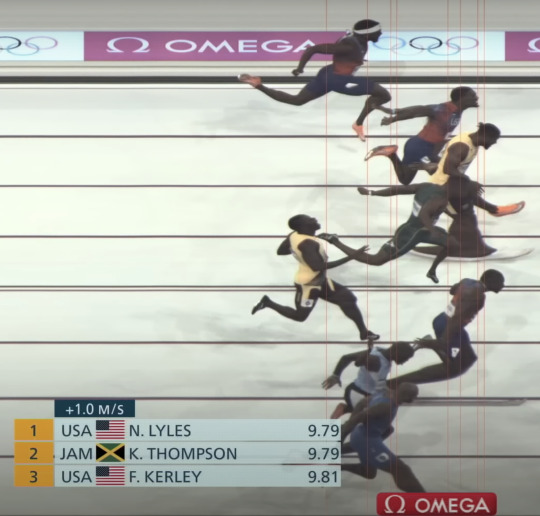
I've been watching the track events at the Olympics since I was a wee lad. It was a tradition in our family. We'd gather around our ancient low-definition 19 inch CRT television and watch tiny blobs compete against other tiny blobs and root for our country.
It was a bit like watching YouTube on your phone in 144p.
Several heroes emerged.
Jackie Joyner-Kersee was amazing.

You can't forget about Flo-Jo.

And then the Olympics decided NBA players were allowed in the competition.
Which formed... The Dream Team.
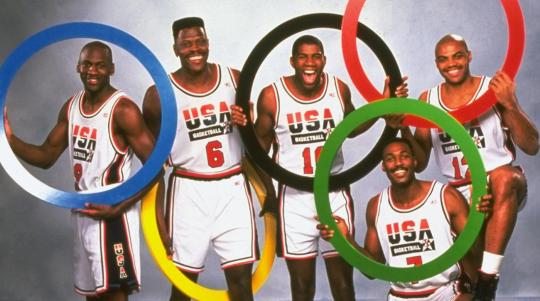
Was this fair?
Well... they won each game by an average of 44 points.
So... no. It was not fair.
Though it became more fair as time went on.
But, umm... yeah. The other teams looked like the Washington Generals and the US looked like the Harlem Globetrotters if they stopped screwing around half of the game.
But my absolute favorite Olympian was a runner named Michael Johnson.

He was cool as heck.
For one thing... gold shoes.
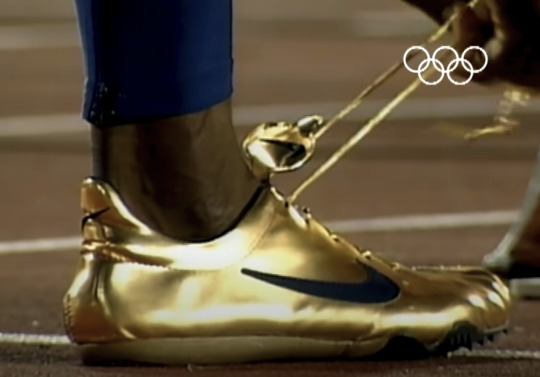
But he also had this crazy, upright, Tom Cruise-ish sprinting style that just made him look like a running robot on the track.

And in the 1996 Atlanta games he just trounced EVERYONE. I mean, it wasn't even close.
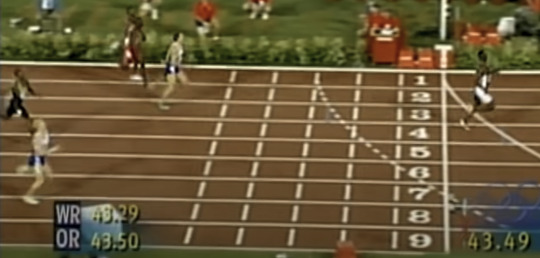
Yikes. Those losing blobs are probably really embarrassed.
Last night I decided to invigorate my nostalgia and watch the track events again. And I got to see one of the wildest races in history.
It didn't even last 10 seconds but it was one of the most exciting sporting events I've ever witnessed. Almost every runner won the race.
After I saw that initially, I was like... who the heck won???
Even in slow motion I wasn't sure.
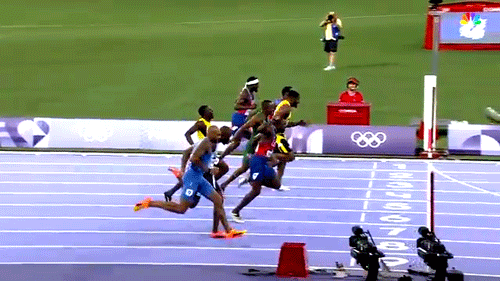
This was one of the closest finishes in history. There has never been a race where all 8 runners were within this margin.
The arena was silent as the winner was being confirmed. The runners just kind of paced around waiting for official word. My best guess was the Jamaican runner, Kishane Thompson. But then the loudspeaker announced Noah Lyles.

The last tiny morsel of American pride burst out of me with a big "Wooooo!"
I forgot what it was like to be proud of my country. I wish it happened more often. But this young man, despite being last place in the first 3rd of the race, turned on the afterburners and won in a photo finish.
And that's when my inner nerd took over.
Because when they showed the photo finish image, it looked super weird.
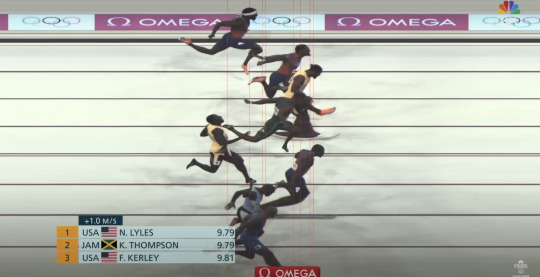
Why is the track white?
Why do all of the runners look all warpy like that QWOP game?

So I went down a research rabbit hole to figure this out.
Photo finishes are actually fascinating. The first photo finish captured the end of a horse race in 1890. But that was mostly luck and timing. The actual photo finish mechanisms weren't used until 1937.
Originally they would film the finish line through a physical slit.

And the first horsie head that appeared in that slit would be the winner. This technology ended a huge aspect of corruption in horse race fixing almost overnight.
But we have come a long way since then. And I'd like to introduce you to the Omega Scan 'O' Vision Ultimate.

This slow motion camera sits fixed on the finish line of every race. The concept of the photo finish has remained remarkably similar to the 1930s approach. The camera sensor is specially designed to only record a vertical slit.
Only the finish line itself is actually captured.
And because it limits what it records to only that slit, it can capture 40,000 frames per second to get amazing temporal resolution.
So why don't the photo finishes just look like, well... this?

That is because the camera takes a picture of time more-so than dimensional space. I guess it would be more accurate to say it *assembles* a picture of time.
As the runners cross the finish line, the camera combines all of the little strips of pictures into a single image.
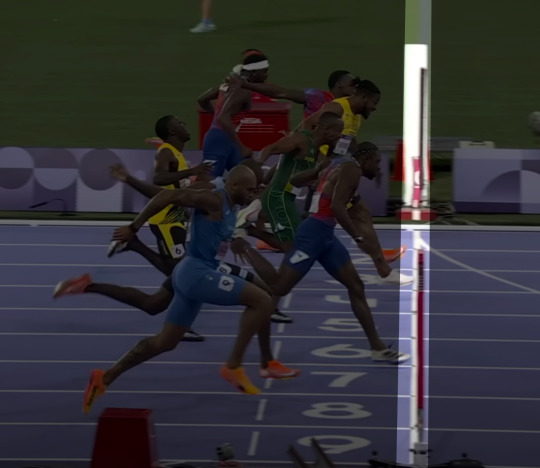





It's almost like if you tried to reassemble a piece of paper after it had been shredded.
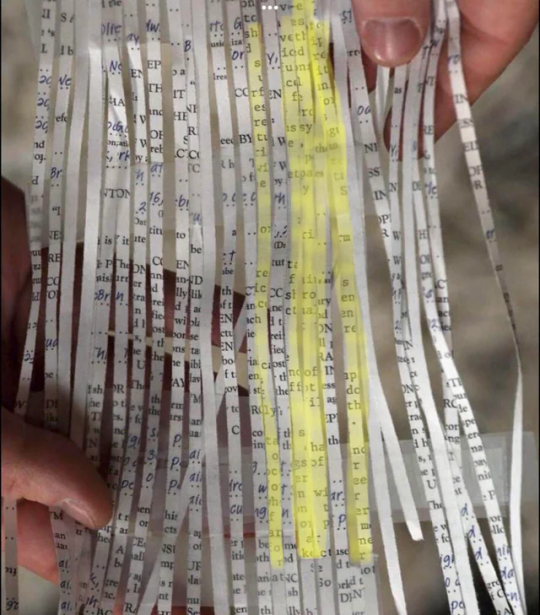
Imagine each strip of paper is a picture of ONLY the finish line, just at a slightly different point in time.
What if someone stopped on the finish line and didn't move... what would that look like?

Once they got there, the same part of their body would just be repeated.
So the right side of the photo finish picture represents earlier in time and it just assembles the image strip by strip as time passes and you literally get a picture of time itself.
NEAT!
Okay, but how do they determine the winner from the photo finish?
I mean, that shoe looks like it is ahead of Noah Lyles!
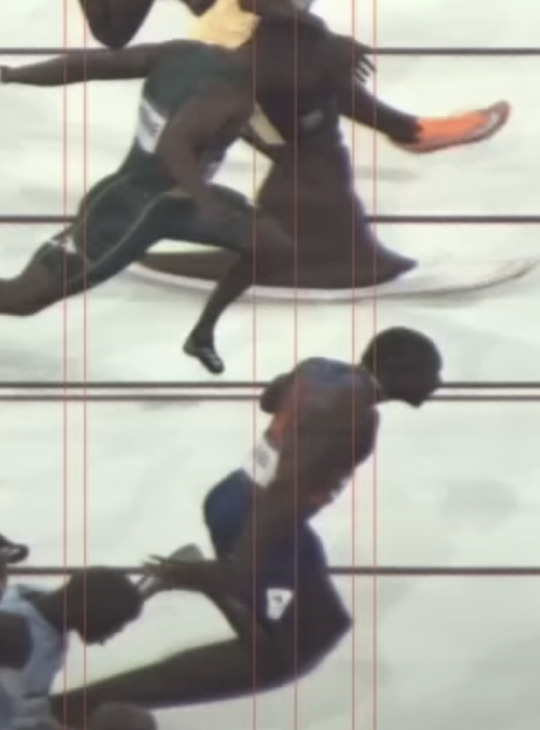
Clavicles!
The IAFF rules state the foremost part of the torso must cross the finish line first. And the endpoint of the torso is the outer end of the clavicle.
So if you get this bone across the finish line first, you win the race.
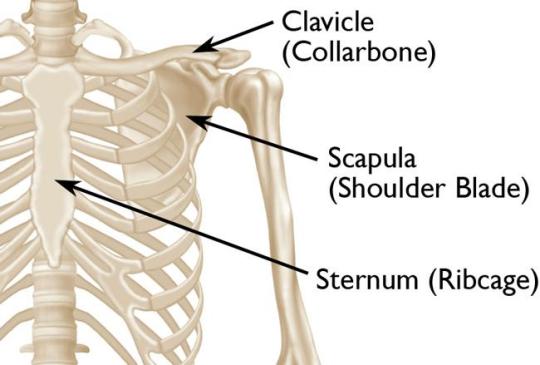
Two more fun facts!
The start of the race is actually just as carefully timed as the end of the race. There are sensors in the starting blocks of each runner.
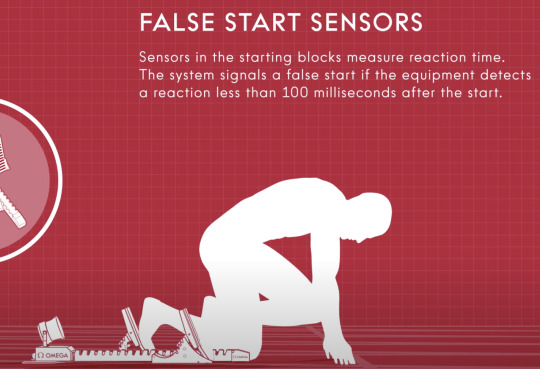
The starting gun also has an electronic sensor.

They have determined the fastest a human can react to the sound of a gun is roughly 100 milliseconds. So if you start running before 100 milliseconds they know you didn't actually hear the gun, you just got antsy and started running too early.
And the final fun fact...
Did you notice the Omega logo at the top of the photo finish?

That isn't superimposed or added after the fact. That is captured by the camera.
But if this image is composed only of tiny little slivers, how did they get the Omega logo to show up?
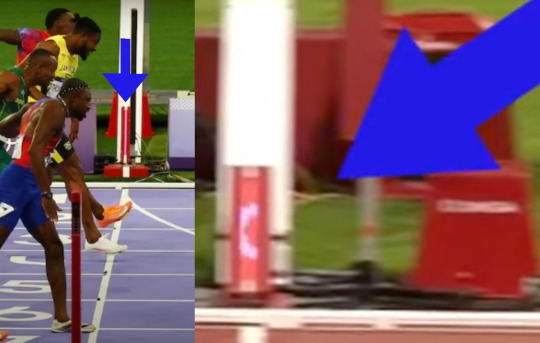
That is a little display. And it is synchronized with the Scan 'O' Vision Ultimate to show a little sliver of the Omega logo for each frame captured.

So when the final image is stitched together, it looks like a cohesive logo at the top of the photo.
Pretty clever, Omega!
26K notes
·
View notes
Text
Time and history: critique of the instant and continuum
Book chapter by Giorgio Agamben

"Every conception of history is invariably accompanied by a certain experience of time which is implicit in it, conditions it, and thereby has to be elucidated. Similarly, every culture is first and foremost a particular experience of time, and no new culture is possible without an alteration in this experience. The original task of a genuine revolution, therefore, is never merely to 'change the world', but also -and above all - to 'change time'."
Chapter provides an historical overview of different conceptions of time (including the shape they are - cyclical, linear etc). Discusses the ways it is re-thought and conceptualised (from a Western perspective). From Greek, to Hegel, Marx, Heidegger, Benjamin
the chapter ends:
"a revolution from which there springs not a new chronology, but a qualitative alteration of time (a cairology), would have the weightiest consequence and would alone be immune to absorption into the reflux of restoration. He who, in the epoche of pleasure, has remembered history as he would remember his original home, will bring this memory to everything, will exact this promise from each instant: he is the true revolutionary and the true seer, released from time not at the millennium, but now."
0 notes
Text
By Meng Zhang and Judith A. Hudson
Abstract:
Temporal concepts are fundamental constructs of human cognition, but the trajectory of how these concepts emerge and develop is not clear. Evidence of children’s temporal concept development comes from cognitive developmental and psycholinguistic studies. This paper reviews the linguistic factors (i.e., temporal language production and comprehension) and cognitive processes (i.e., temporal judgment and temporal reasoning) involved in children’s temporal conceptualization. The relationship between children’s ability to express time in language and the ability to reason about time, and the challenges and difficulties raised by the interaction between cognitive and linguistic components are discussed. Finally, we propose ways to reconcile controversies from different research perspectives and present several avenues for future research to better understand the development of temporal concepts.
#temporality#linguistics#my speech#lang link#found this while looking for something to refresh my memory on temporal concepts#temporal#tense#aspect#modality
0 notes
Note
i would actually like to hear more of your thoughts on whipping girl, whenever you feel ready enough to talk about it. i've only ever heard positive recommendations for it. i was thinking of reading it. i've read one or two introductory 101 texts on transmisogyny as well as some medium/substack posts, and always looking to read more as a tme person. ty!
thanks for asking! I'm gonna try to be concise because I'm stuck on my phone for the month, but here are my thoughts on whipping girl:
serano is at her strongest in the book in three areas: manifestations of transmisogyny in media (e.g. how trans caricatures pervade movies), the history of medical institutions developing a pathology of transsexuality (like the diagnostics of blanchard et al. or how trans people seeking healthcare were and continue to be forced into acting out prescribed expressions and manufacturing memories), and the construction of her own transition narrative (telling the reader what it was like for her to grow up desiring femininity in a way that confused her, the experience of crossdressing, the effects of hrt for her)
whenever she's just sticking to this, I think she effectively communicates a lot that the unaware reader could benefit from—even many trans women/transfems/tma people who are otherwise in tune with the history of medicalized transsexualism and our popular depictions could probably benefit from her own personal narrative, by nature of how variegated our experiences can be.
unfortunately I think the book fails at its primary—stated—goal, which is to theorize about transmisogyny. in the big picture this is a bifurcated failure:
on one branch of her argument, she remains committed to there being something biologically essential/innate about gender. this manifests thru multiple claims: that we have "innate inclinations" toward masculinity/femininity and "subconscious sex" rather than what I believe, which is that the latter are constructed categories imposed on different matrices of behaviour/expression/desire in different cultural contexts; that there is "definitely a biological component to gender" (close paraphrase) after a discussion of how she believes E and T tend to affect people (thus equivocating gender with dominant hormones!); that we have such a thing as "physical sex" which is the composition of our culturally decided "sex characteristics" (don't ask me how the dividing line is drawn) even as she says we should stop using "biological sex" as a term; that there is "no harm" in agreeing that "sex" is largely bimodal with some exceptions; that social constructionism is necessarily erasure of transsexual experiences in early childhood... altogether she is unwilling to relinquish arguments about the partial "innateness" of femininity/masculinity and gender. this is at tension with her admission on several occasions that these are neither culturally/geographically nor temporally stable concepts! but that doesn't seem to be a line she can follow thru on.
on another, intertwining branch, she engages in what I think is a deep and widespread mistake in the theorizing of transmisogyny: reducing it (mechanistically) to what she calls effemimania* or essentially anti-femininity. it is her stated thesis at the start that masculinity is universally preferred to femininity. she doesn't offer a definition of either term until one of the final chapters, where she defines them as the behaviours and expressions associated with a particular gender. but I think this reduction just misunderstands transmisogyny. it is even in tension with an observation she makes early on, that trans women are often punished for their perceived masculinity! but again, this is a thought she seems unable or unwilling to follow thru with.
my problem with the thesis is that masculinity and femininity do not float free of gender—it is not possible to speak of their valuation in the abstract. anyone who grew up as a masculine cis girl and never "grew out" of that "phase" can attest to the violence wrought upon expressions of masculinity from women. and this applies doubly so to the subjects of transmisogyny! not only are we punished for any perceived bleed-through of masculinity from our supposed "underlying male selves", those of us who are willingly masculine and thriving as mascs are punished for our failure to conform to the rules of the normative womanhood that is imposed on us (just as we are punished for any willing femininity as "false" and predatory upon cis womanhood—observe that transmisogyny is reactive degendering in every case!).
on both branches serano makes only perfunctory remarks about the intersections with race, class, and colonialism. "sex" as such was made to only be accessible to the "civilized", most of all the white european! for a racialized person and particularly a Black person navigating gender the waters are just not the same; the signifiers of sex neither available in the same way, nor granted the same medical legitimacy. what is the "physical sex" of someone who is de-sexed altogether? how can gender have a "biologically innate" component when its expressions between the bourgeoisie and the working class are at total odds with one another? this all goes for the masculine/feminine distinctions as well. what sense is there in the claim that we have innately masculine/feminine inclinations when globally (and transmisogyny has been made global!) what is feminine and masculine can be very nearly mirrored? nor is "masculinity is always considered superior to femininity" innocent of obviating race. transmisogynoir adds yet further degendering thru the coercive masculinization of someone as a Black woman—masculinization as punishment, again!
and as a final point, the account fails to be materialist. there is no attempt to place transmisogyny in its role as an instrument of political economy or, as jules gill-peterson might say, as a tool of statecraft. it is just a psychological response to the way the world is, as far as serano has anything to say about it. but how did the world become that way, and why?? serano's solution, the abolition of what she calls gender entitlement, is naive to the fact that gender entitlement is necessary to the maintenance of the capitalist state, which is structured thru patriarchy and built on colonialism. it is not possible to reskin this into something innocuous!
this is why I cannot recommend whipping girl as a work about transmisogyny except at the most shallow level. it could be a helpful critical read, but imo, it is just wrong about transmisogyny.
2K notes
·
View notes
Text
“Tell me about magic,” I said to the god wearing my friend’s corpse.
It (I would not grant it the honor of using her name) smiled at me the way she used to smile. It looked like shit, by the way, streaked with mud and blood and slowly spinning new flesh from atmospheric carbon to patch up the bullet holes our latest acquaintances had left it.
“I know every word in your human languages and none of them suffice. How would you explain a black hole’s accretion disk to a fish?”
“I don’t know. Try.” I didn’t bother voicing the threat but it was implicit, as it was in all of our conversations: your kind has died only once before, but it was at the hands of mine.
It sighed with the weariness of a parent about to talk down to a kid, but it signed up for this when it trapped itself on this rock with me. “It’s a puzzle that’s almost been solved since forever began, a puzzle of infinite complexity worked on by the million sharpest minds to ever be, all themselves fractured into dizzying arrays of subminds in temporally upspun pocket universes, all striving to refine those secret arts of law and mastery. It’s cooperation and competition, vines of knowledge strangling each other as we reach ever upwards towards the sun, clawing at each other in our desperate want. It’s a science. It’s like breathing. It’s like love.”
“I distinctly recall you saying that love is an idiocy reserved for us mortals, and a more efficient chemically-induced blindness than sodium hydroxide too.”
“And I maintain that stance, but it gets the point across, does it not?” It huffed with exasperation, you know, the way that she had a thousand times when we were young. An affectation? Or a bit of humanity bleeding into the monster?
“Mhm. Sure.”
It side-eyed me but kept talking. “You don’t have the point of view it would take to truly understand magic. You never will. Even if you saw the world the way I did, you wouldn’t have the context or the time to decipher it. For you it can never be a science, only ever an art.”
“You say that like it’s a bad thing.”
“In truth I envied you. With infinity at one’s proverbial fingertips, what else is there to do? The greatest possible workings have all been deduced, those most absolute and inviolable inflictions of the will upon the cosmos, and all that remains to study are the fleeting shadows of concepts beyond even us. But you humans, you tread on new ground that we’ve long since mastered, internalized, and then forgotten. The best you can manage without literally blowing your own minds is a little teleportation. You’re clueless and flawed and you fuck it all up whenever you get the chance. And I envied you.” For a creature enamored with paradox, the idea of a god envying a mortal sure pained it.
“So you cut it all free, cast off the godhead, and came down from on high to slum it with we mortals. I bet you’re regretting that now,” I said, sticking my finger in the last bullet hole and giving it an experimental wiggle. It winced, but the wound closed up like it had never been as I withdrew my finger. Pain is a just a signal, it was always fond of saying. But it still cried whenever it lost a limb.
“Not in the slightest,” said the once-god wearing my friend’s corpse. “This is the most alive I’ve felt in eons.”
#viscera star#kind of#this is a scene i wont ACTUALLY put to paper for like. Years#but i wanted to write something today and it was this#and fuck it i figured i might as well post it#lucy viscera star#katie viscera star
921 notes
·
View notes
Text
current progress in theories of ecological succession!!!!!! This paper lists 19 different ecological succession theories and their perspectives and limitations
Before I knew its name, I knew succession....I still remember the exact moment of realizing the endless flow of change moving through the ecosystem around me. Looking at weeds, shrubby woods, gardens, and fields, I was seeing this unfolding and expanding web of trajectories and possibilities, and it was like peering into the secrets of the universe.
And ever since I've paid attention to it. Constantly observing the movement in ecosystems and its patterns.
All of these theories are partially correct but incomplete. How could we ever come up with a complete theory of succession? It's like studying the convergence of order and chaos itself. Some of the important tensions of succession brought up in this paper are:
Does the environment determine which plants survive, or do the plants that survive determine the environment? (both)
Does the plant community before disturbance determine post-disturbance regeneration, or does dispersal of new plants determine it? (both)
Are communities at different successional stages formed by whatever random assemblage of plants happens to exist at that stage, or are plant communities adapted to form certain stages of succession? (both)
Is succession a process of maturity of one big thing, or cycles of death and life of a bunch of smaller things? (both)
Do plants exclude other plants from niches as succession progresses or do they open up new niches? (both)
Is succession cyclical or linear? (both)
and like ok. this topic will get me sounding like some kind of deeply unscientific weirdo because I will be like Yes, The Weeds Taught Me The Secrets of Order and Chaos. but also this is a topic in science where all the literature written for non-layperson specialist audience makes Sense.
I was really excited reading this paper because this is like, the stuff I think about randomly all the time. like the other day I just basically blacked out and wrote like 2000 words about The Nature of Disturbance and Temporal and Spatial Dimensions of Ecosystem Change not even thinking about how I was writing about succession, and almost made my brain blow up.
like each successional theory developed so far has highlighted part of the big picture but there are several pieces of the puzzle that have barely been articulated yet. my questions:
Disturbance: What Does It Mean. When talking about something alive and changing, there is no stable state of being, so what does it mean to "disturb" an ecosystem? Every ecosystem is maintained by disturbance, like in an old-growth forest animals will graze and trample and trees will occasionally die and fall and there will be storms and fires and that is part of what a forest is. So like...where is the line between a disturbance that maintains an ecosystem at "climax," and a disturbance that makes the ecosystem no longer "climax."
disturbance, even the most severe and devastating disturbance with near 100% mortality of all plants, does not fully erase the previous plant community. so like, early-successional communities aren't a blank slate, but there is a such thing as an "early-successional community" in the sense that weed species not visible in the pre-disturbance community will pop up. Now, a lot of the theories assume that long-distance seed dispersal (and the availability of seed sources and dispersers) influences the arrival of weeds, but I think the soil seed bank is just as important if not MORE important. Do all soil seed banks have plenty of weeds? Do they have different weeds or the same weeds? Do those weeds match what was there the last time there was a weed community on that site?
disturbance is usually distributed over the land SUPER unevenly except in cases of lawns, logging and industrialized farming. at what spatial scale do edge effects irretrievably muddle the concept of discrete early-successional or late-successional communities. Like if you go into the forest and bulldoze a patch of forest down to bare dirt, that patch is fundamentally different from the bare dirt in a huge housing development, just because of being directly adjacent to a forest. Even completely disregarding seed dispersal- it's shaded, it is affected by the leaf litter and fine woody debris, etc.
I would tentatively state that linear processes of change occur in most man-made environments that are disturbed cyclically, for example, lawns- intensively managed monoculture lawns seem to persist in a lush state for a short time before the grass starts to die. most tilled agricultural fields are losing topsoil and fertility in a linear fashion. so like, the land has an accumulative legacy of tens or hundreds of disturbance cycles. Isn't this likely to be true on a much larger temporal scale? Like, is a forest ecosystem now affected by the fact that it was a prairie 1,500 years ago?
likewise, might this accumulative legacy be necessary for certain ecosystems to reach a "climax" state? e.g. prairie will overgrow into woodland in a few decades absent any disturbance, but cyclic disturbance by fire allows the cumulative progression of a larger successional process
288 notes
·
View notes
Text
Uh yeah that's because they're dating LOL😂
As far as I can tell, girlposting on Tumblr operates according to roughly the same principles as the Border Mythic in the tabletop roleplaying game Nobilis: specifically, it is the power of attention which distinguishes a girl from her environment. Not only may any thing be a girl, but each constituent of a girl may itself be raised from the welter of experience and awakened to girlhood through the power of diligent observation. Thus, the rivergirl is a girl whole and complete, yet if one looks more closely, each droplet of water which comprises the rivergirl will resolve itself into a dropletgirl; and each molecule of H₂O making up each dropletgirl, into a moleculegirl; and so forth; and yet the rivergirl remains one and whole.
#also not inaccurate but i would contextualize it separately#girlposting has a temporal aspect#girlposting is essentially a shortform vignette which describes outlines or bounds a mundane or surreal made mundane wcenario#in which the girl is the central figure and some aspect of their nature is the core of the scenario#hence why girls are never named in girlposting merely titled descriptively#this conception has limitations; ice (rest in peace) is undeniably the originator of girlposting in my mind#and they did tell longer vignettes and novellas with a recurring cast#basically girlposting goes like this:#'put that beast in a situation'#'that beast IS the situation'
2K notes
·
View notes